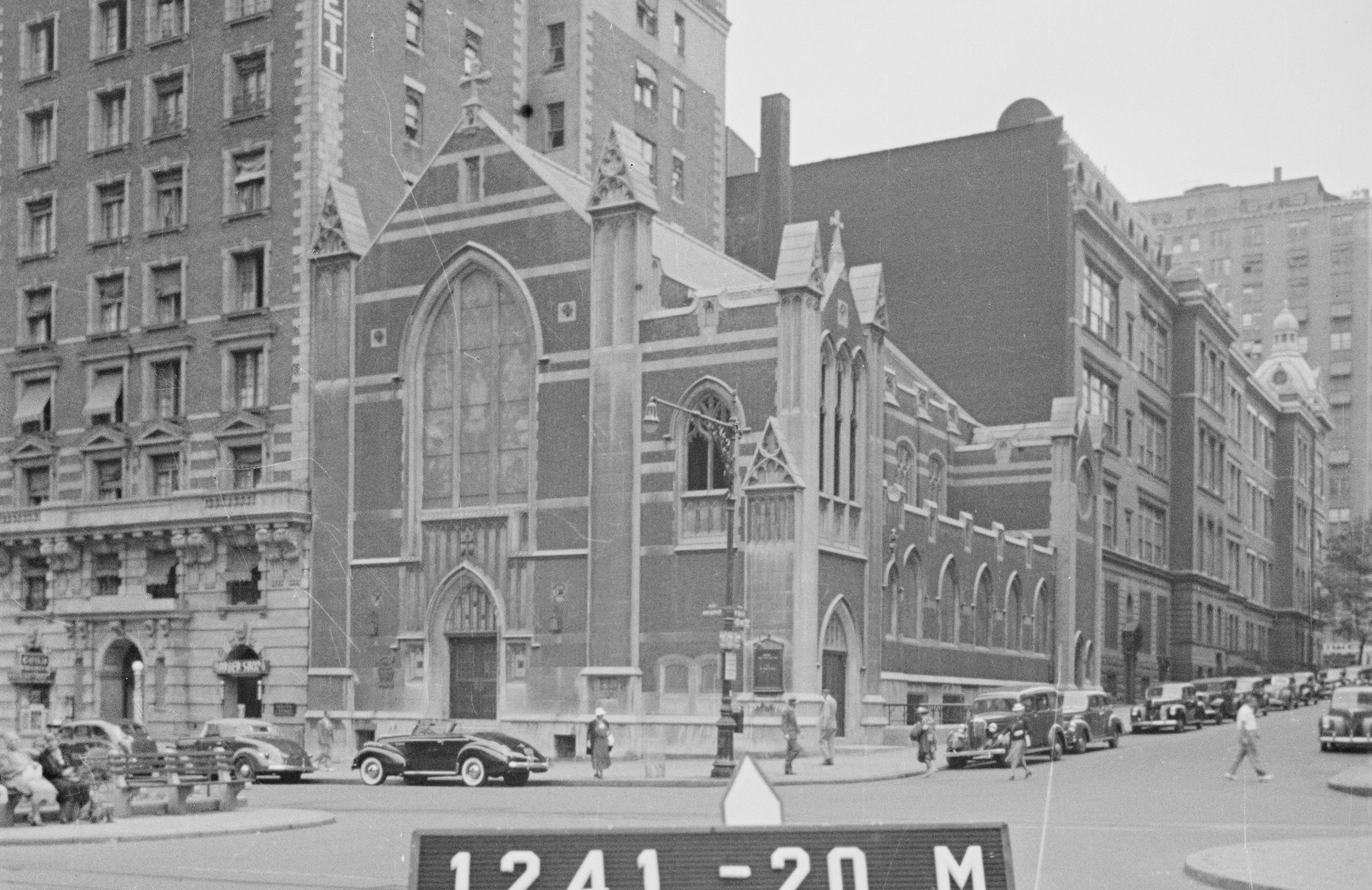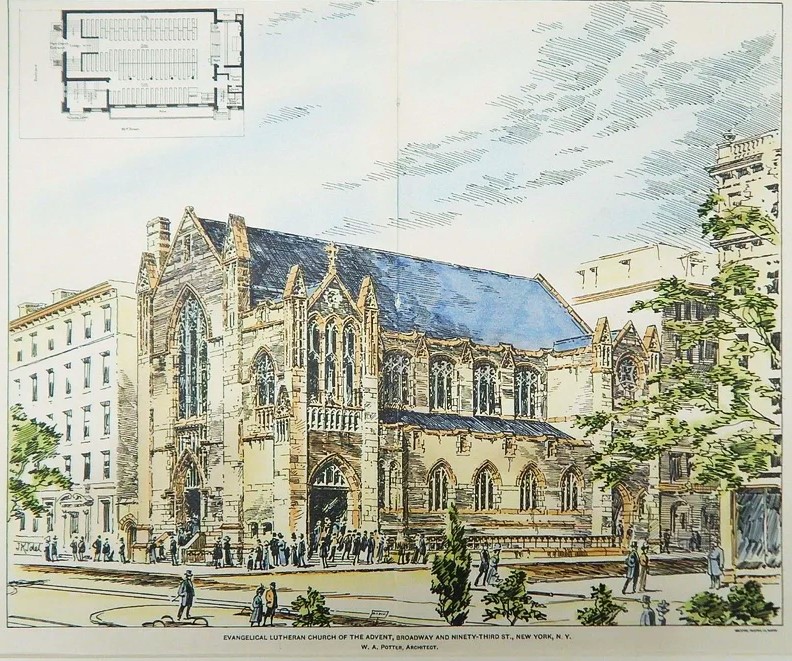
Evangelical Lutheran Church of the Advent
by Tom Miller
On February 28, 1900, John O. Baker sold the vacant plot at the northeast corner of Broadway and 93rd Street to the Evangelical Lutheran Church of the Advent for $54,000. Just over four months later, on June 19, architect William A. Potter filed plans for a “one story brick and limestone church” which would cost $70,000, bringing the total outlay to more than $4.1 million in today’s money. In reporting on the filing, the New-York Tribune noted, “The congregation, of which the Rev. Dr. C. F. Krotel is pastor, now worships in the hall of the West Side Republican Club, Broadway, near Eighty-fourth-st.”
The son of New York Bishop Alonzo Potter and brother of Bishop Henry Codman Potter, William A. Potter had served as a Supervising Architect of the United States Treasury from 1874 to 1877. Now, instead of Government buildings, he was better known for churches and the numerous buildings he designed for Princeton University.
For this project, Potter turned to what the Luther League Review called “a style of modern English Gothic.” It was the architect’s personal, somewhat truncated take on Collegiate Gothic. Faced in red and black brick and trimmed in Indiana limestone, the Broadway elevation stressed the vertical, with full-height stone piers and a soaring Gothic window. The stained-glass windows, as well as the ceramic altar mosaic, was executed by Tiffany Studios.
The Evangelical Lutheran Church of the Advent was only three years old, organized by Rev. Charles Frederick Krotel in 1897. This was the second congregation he founded. In 1868 he organized the English Evangelical Lutheran Church of the Holy Trinity. By the time the Church of the Advent moved into its “fine new building,” as described by the Luther League Review, Rev. Krotel had “built up a flourishing congregation on the upper west side.”
The architectural critic of The Sun was somewhat tepid in his assessment of the new structure, calling it “one of the most recent examples of a comparatively inexpensive city church.”
The church was consecrated on April 14, 1901. In reporting on the upcoming event, The New York Times mentioned, “One of the women members of the congregation has contracted with a well-known organ builder to put in a fine new organ as a memorial, and this is to be ready on May 1.” Tiffany Studios received the commission to decorate the front pipes of the instrument, as well.
The architectural critic of The Sun was somewhat tepid in his assessment of the new structure, calling it “one of the most recent examples of a comparatively inexpensive city church.” He said, “although there is no spire, the suggestion of corner towers adds to the churchliness of the structure. One excellent feature of the plan of this building is that it harmonizes with surrounding structures.”
On May 17, 1907, six years after his church was completed, the Rev. Dr. George Frederick Krotel died of a stroke at the age of 82. In reporting his death, The Sun called him “one of the best known Evangelical Lutheran clergymen in the State.” So beloved was he by his congregation, that nearly two decades later, on May 17, 1926, The New York Times reported, “The Krotel Centenary was observed yesterday at the Evangelical Lutheran church of the Advent.” Rev. A. Steimle compared Krotel “to the Gospel of St. John, v. 31: ‘He was a burning and a shining light.’” In his remarks, Steimle said, “A more fruitful life I do not know. His influence is still felt among us.” Indeed, ten years later, on December 27, 1936, during the 40th-anniversary ceremonies for the church, a memorial service for Rev. Krotel was included program.
Jazz music was often—almost always—a part of the services at the Advent Lutheran Church. But a particular funeral outshone any other event. Famous jazz composer, pianist, and arranger Tadd Dameron died on March 8, 1965, and his funeral was held three days later. The New York Times began its reporting on the services by saying, “The Benny Golson Jazz Quintet played ‘The Squirrel’ yesterday at a funeral in the Advent Lutheran Church at Broadway and 93d Street. It was one of the late Tadd Dameron’s favorites and his friends said he would have loved it.”
About 150 musicians, “all well-known in the world of jazz,” were in attendance. The article said that Rev. Gensel “let the music speak for itself—and for Tadd. There was one hymn, ‘Nearer My God to Thee,’ but the Golson Quintet carried the burden of the service.”
In 1977 Rev. Gensel was relocated to St. Peter’s Lutheran Church in Midtown, where he continued his “jazz ministry.” But that did not end jazz music at Advent Lutheran Church.
Eventually, the Lutheran Board of American Missions allowed Rev. Gensel to devote half his time to ministering to the jazz community and the other half to his church duties.
On November 24, 1983, The New York Times reported on the Thanksgiving dinner the church had supplied to 350 men and women from welfare hotels. “At 7 A.M. a battalion of 27 cooks and servers began arriving in the cramped basement kitchen, with its eight-burner stove. Martha Sickles…brought her jazz records.” As a matter of fact, the annual feast was founded by jazz musician Billy Moore.
Feeding several hundred people a proper Thanksgiving meal required much help. Film stylist Lynn Tonnessen, said the article, “spent two nights baking 35 pumpkin and apple pies. There were 33 turkeys including the first one ever prepared by Art Fried, a Legal Aid lawyer.” Eight of those turkeys were prepared by Mayor Ed Koch’s chef, Mitchell London, who also turned out 500 chocolate chip and oatmeal cookies.
Music continues to be a mainstay within the congregation. An especially notable musical event was “Moondog Rising,” in October 2007. The two-day music festival paid homage to the late Moondog, a long-haired, bearded blind man who had worn a handmade Viking helmet and cloak. The New York Times recalled, “he regularly stationed himself at Sixth Avenue and 54th Street, which cops and cabbies knew as Moondog’s Corner. Dispensing his poetry, politics, sheet music and recordings…he was sought out over the years by beats, hippies and foreign tourists, but also by the media and celebrities.” Moondog Rising included “music by Bach, Beethoven, Mozart, Ives, Carter and Kirchner, all playing second fiddle to the classical works of Moondog,” said The New York Times.
Classical joined the jazz and off-beat music as well. In 2019 the church presented its Music Mondays series, including, for instance, a pairing of violinist Jennifer Koh and bass-baritone Davone Tines “in music that ranges from Bach and Beethoven to Julia Wolfe and Missy Mazzoli to a hymn and a Korean lullaby.”
In 2007 the congregation began an ongoing $1 million fund-raising project to completely restore the Tiffany Studios windows.
Tom Miller is a social historian and blogger at daytoninmanhattan.blogspot.com
Building Database
Keep Exploring
Be a part of history!
Think Local First to support the Advent Lutheran Church at 2504 Broadway:
Meet Amanda Gray!



